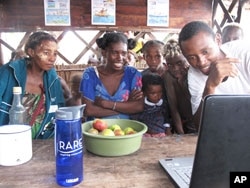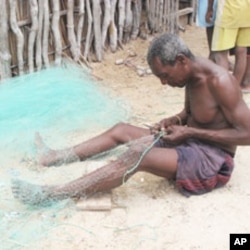Since the food crisis of a few years ago, much attention has been paid to improving agriculture and conserving the land. But land is not the only source of food. The oceans provide food and jobs for millions of people, yet very little is being done to protect them.
Marine conservationists say less than one percent of the world’s oceans are protected. They say the seas need protection from people, who take from their bounty, often without regard to the consequences – or even awareness of the results of their actions.
Playing catch-up
Steve Watkins, senior vice president of RARE, a conservation group in the Washington, D.C., area, says, “It’s been much easier to initially focus on the terrestrial world, the landscapes we see, because we all live and walk around on the land. And it’s just the first thing that comes to mind. So, in a sense there’s a bit of catch-up in terms of paying attention to the oceans that needs to happen.”
RARE, a nonprofit group, is working in 50 countries to get local communities to treat the seas with more respect and with an eye toward the future.
“We firmly believe in helping local communities to address their own environmental issues, which is why we seek out community leaders, that we can kind of train and mentor and help them to succeed. So it’s about sort of their growth and them address their problems rather than us running our own projects,” says Watkins.
Oceans at risk
He describes oceans as being “dramatically threatened.”
“Many governments, less developed around the world, have really for the last 50 years or more viewed the expansion of their fishing fleets and their fish catches as one of their economic development objectives. And that’s just become so efficient in the last decade that it’s just got so far ahead of the oceans’ ability to reproduce and stay healthy,” he says.
That’s why Marine Protected Areas are being set up around the world and monitored by local communities.
“(It’s) an area of the ocean,” he says, “ that people that people agree to set aside to either fish less or not fish at all. So that the fish and other creatures that live in that area of the ocean can live out their life cycle. Grow big, have more children. In a sense become kind of a bank account, which accumulates interest in the sense of productivity of the environment. And it can really help to repopulate the more productive fishing grounds.”
Good intentions, bad results
For example, Watkins says a Maritime Protected Area is being set up in southwestern Madagascar.
“It’s really a microcosm of what’s happening perhaps the world over, where, for many centuries, the ethnic group that lives there – they’re called the Vezo people – have really lived in harmony with the ocean. They’re a semi-nomadic seafaring people,” he says.
Then, despite the best intentions, things began to go wrong. Both fish and their habitat suffered.
“They’ve begun to have access to things like poison. Even things just like household bleach can be used as poison in the oceans to kill all the fish so they float to the surface for harvesting,” he says.
He adds, “They’ve started to receive things like mosquito nets to obviously address very important health issues for the community. But those mosquito nets, if they’re used as fishing nets, are so, so fine that they lift all of the fish larvae and juvenile fish, as well as the larger fish people are trying to catch. So (they) stop those larvae from growing into future fish for people to catch.”
Reefs were also destroyed when the Vezo people used mining picks to break the coral apart looking for octopus. Previously, they might have used sticks to probe holes in the reef. In the short term, the mining pick method appears more productive, but it has long-term consequences as the home of marine life is shattered.
The senior vice president of RARE says if the local populations are empowered to care for the oceans and their food supply, they will see the benefits of using sustainable fishing methods.









